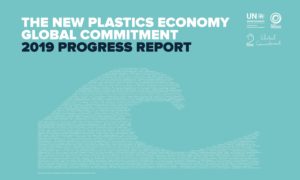All of L’Oréal’s plastic packaging will use eco-friendly materials by 2030: Global Brand President
L’Oreal Paris recently announced the company’s sustainability program, “L’Oréal For the Future, Because our Planet is Worth it”, initiating the brand’s latest set of ambitions for 2030.
L’Oréal Paris plans to reduce its carbon footprint by 50 percent per finished product. It will also contribute 10 million Euros to environmental projects whose beneficiaries are communities of women around the world.
Sonal Bhutra spoke to Delphine Viguier-Hovasse, Global Brand President, L’Oréal Paris to understand the brands’ outlook, plans and sustainability initiatives.You have launched a new program, L’Oréal Paris sustainability program, L’Oréal for the future, can you take us through what are your plans to ensure sustainable business practices? What is the target timeline?
As a beauty brand, many of our raw materials are sourced from nature. We, therefore, have always had a strong understanding of our planet’s beauty, its fragility, and the role we can play to preserve it. Since the 2013 launch of L’Oréal’s sustainability program, Sharing Beauty With All and the subsequent L’Oréal for the future in 2020, the group has outlined key, tangible targets to fight climate change, manage water sustainability, respect biodiversity, and preserve natural resources in the development of a circular economy. We have been particularly focused on contributing to the group’s environmental goals by reducing our carbon footprint. Since 2020, 93 percent of L’Oréal Paris’ new & renovated products were improved based on the life cycle methodology. Between 2005 and 2020, L’Oréal Paris factories and distribution centres have reduced CO2 emissions by 82 percent, water consumption by 44 percent, and waste generation by 35 percent. To build upon our achievements to date and in line with the group’s ambitions, L’Oréal Paris is now launching a new ten-year plan to reduce its carbon footprint by 50 percent by 2030, while contributing 10 million euros to environmental projects in the next 5 years. The beneficiaries of these projects are communities of women around the world.
We pledge to reduce by half our CO2 emissions per product by 2030. And our new sustainable program defines a clear action plan to reduce, on all steps: ingredients, packaging, usage and end of life… Until 2020 the main focus was really our factories, and now, we have to accelerate on all the other impacts, especially tackling products.
By 2030,
- 100% of the plastic we use will be recycled and recyclable
- 100% of our biobased ingredients will be sustainably sourced
- 100% of our factories will be carbon neutral
- And 100% of our employees will commit to our ambition by reducing by half their business trips
Packaging is one big component contributing to pollution. What changes are you making to your product in terms of packaging, constituents and supply chain in that case? What with this do to your emissions overall? Is it difficult to ensure that you abide by the 6 R’s of packaging that you have taken up? What new processes have you undertaken?
We are working on accelerating the shift to a circular economy, where materials are kept in use for as long as possible, by optimizing their packaging recyclability, striving to conserve resources and prevent plastic pollution. This includes using more recycled content in packaging. For example, the iconic L’Oréal Paris haircare range, Elvive, has undertaken a major transformation of its entire value chain by targeting 100 percent recycled PET (polyethene terephthalate) for shampoo and conditioner bottles in Europe, since 2020. To seek alternatives to single-use packaging and propose refill or reuse systems while engaging consumers, L’Oréal Paris will join Terracycle’s LOOP initiative and take part in a project to trial new types of packaging with the retailer Tesco in the UK. The new shampoo and conditioner packaging will be sold with a deposit, on the retailer’s website. After using the products, consumers will be able to return the packaging to the retailer that will collect and return the packaging to L’Oréal Paris for cleaning and refiling. This initiative will be reproduced in across countries in the coming months.Essentially, by 2025, 100 percent of L’Oréal Paris’ plastic packaging will be recyclable, reusable or compostable and by 2030 – 100 percent of the plastic will come from recycled or biobased materials. We will also reduce by 20 percent in intensity the weight of our products (light glass pods)
While talking about the supply chain, an action plan to reduce the carbon footprint of our products and across our supply chain has been defined using an innovative tool that measures the carbon emissions of a brand. L’Oréal Paris is the first brand in the group to have piloted such a tool which allowed us to understand precisely where our principal CO2 emissions come from. This data defined our clear action plan to reduce emissions across our supply chain by using recycled materials and reducing the weight of our packaging, working on the renewability of our ingredients, reducing water consumption during use phase, working on low carbon transportation mode, engaging our suppliers in reducing their carbon emissions, and having carbon neutral factories. As we move ahead, we are committed to accelerating our mission across the supply chain, especially concerning the carbon footprint of our products.
Have you made changes to the product formula/ingredients as well to ensure sustainability? And how are you planning to improve the impact of your products on the environment?
We are committing that by 2030, 95 percent of our ingredients will be derived from renewable, plant-based sources, from abundant minerals, and 100 percent of our formulas will be respectful of the aquatic environment. Our focus will be on bio-based ingredients for formulas or raw materials for packaging, material developed from renewable organic matter (plant, animal or microbial), generally from agriculture, forestry or fishing and which regenerates itself in relatively short cycles (from a few days to a few decades), which last for a period equivalent to the duration of their use. L’Oréal does not use animal biomass, with the exception of rare ingredients such as beehive products or lanolin obtained from wool.For every new project, our products are assessed through a tool called SPOT (Sustainable Product Optimization Tool), which measures the environmental and social footprint of products.
The methodology is based on life cycle analysis principles, measuring a product’s impacts from raw materials to end of life. It considers 14 different factors on which a product creates an impact on the Earth, including carbon emissions, water scarcity and quality, waste pollution, biodiversity loss and resource depletion.
Using SPOT, L’Oréal Paris’ teams are able to allocate a score to each product. If the score does not show an improvement of the environmental and social performance compared to a baseline (in a similar family of product) the product cannot be launched. Through a major collaborative effort, our researchers, product designers, packaging and manufacturing teams continuously work to develop solutions to improve our products’ environmental footprint.
And to go further, we have developed a tool to measure the GHG footprint of the brand, following the group’s methodology. This tool will be updated every year, to track the progress on our carbon reduction target. It covers all scopes (1, 2 & 3)



